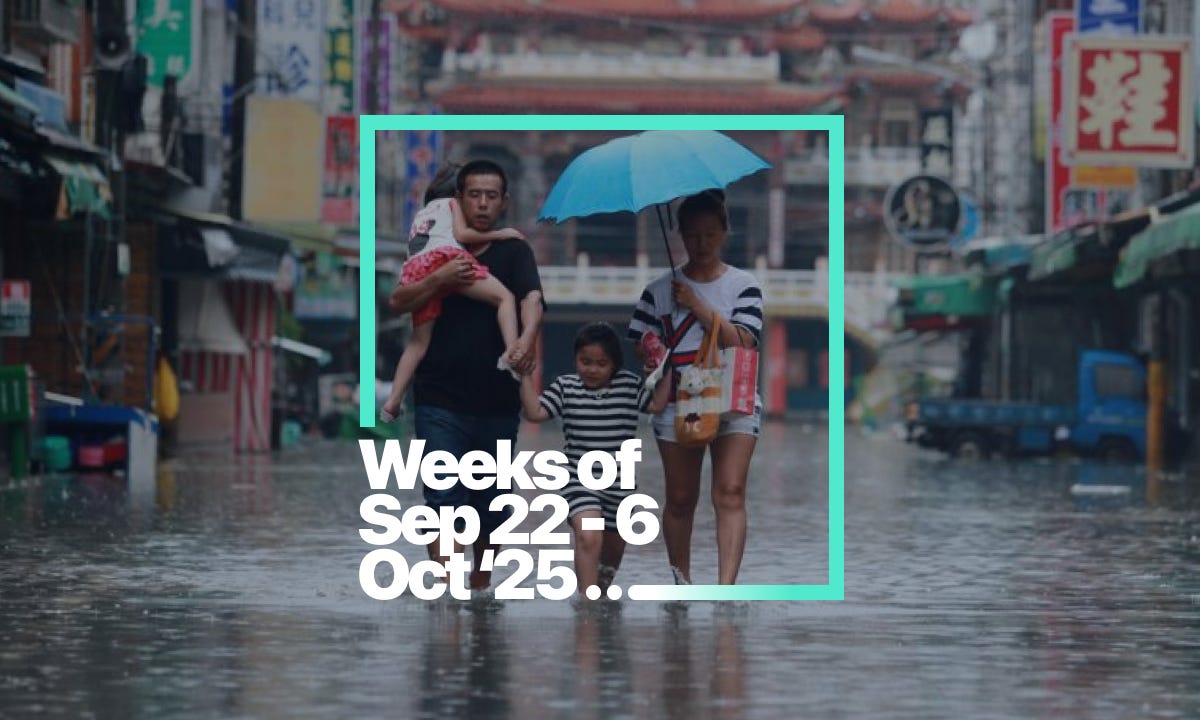Hello 👋 get a brew on because these are the top emerging risks between September 22nd, and October 5th, 2025…
Review our report’s terminology here ↗
Our main risk this fortnight is…
1. Environmental: Asia-Pacific Climate Crisis Intensifies
Super Typhoon Ragasa killed 14 people in Taiwan after barrier lake collapse, evacuated 2 million in southern China, and marked Hong Kong’s 9th typhoon of 2025 versus typical 6 per year—a 50% increase.
Typhoon Bualoi struck one week later killing 88 across Vietnam and Philippines, damaging 44,200 houses and flooding 6,000 hectares of crops with total damages of $656.1 million.
Vietnam’s disaster losses January-August 2025 reached $371 million—almost triple the same period in 2024, demonstrating acceleration in both storm intensity and economic impact.
Syria faces worst drought in 36 years with precipitation 54% below average, wheat production at 900,000-1.1 million tons versus 4 million ton national need, threatening 16 million people.
Three simultaneous climate disasters in 14 days across different geographies expose new reality of compound, cascading environmental risks.
Sources
You should be concerned if…
Operations in Asia-Pacific or MENA regions: Businesses with supply chains, manufacturing facilities, or logistics operations in the Philippines, Vietnam, Taiwan, southern China, or Middle East/North Africa face direct exposure to intensifying climate events.
Agricultural commodity dependencies: Organisations relying on wheat, barley, or grain supply chains with any exposure to Mediterranean or Middle Eastern sourcing face food security disruption risks.
Manufacturing and electronics sectors: Just-in-time inventory systems and concentrated supplier bases in typhoon-prone Southeast Asian manufacturing hubs create single-point-of-failure vulnerabilities during simultaneous climate disasters.
Insurance and financial services: Escalating disaster frequency and costs signal premium increases, coverage restrictions, and potential uninsurability of high-risk regions affecting business viability calculations.
These items are generic assumptions. We recommend considering your own unique risk landscape against your critical dependencies. If you don’t know what they are, get in touch.
Preventative actions
Conduct climate exposure audit
Map entire supply chain against climate risk data including Pacific typhoon belt, Mediterranean drought zones, and flood-prone deltas. Go beyond tier-one suppliers to identify hidden vulnerabilities in critical component sourcing.
Diversify supplier geography
Qualify backup suppliers in different climate zones if single-sourced from climate-vulnerable regions. Accept higher costs as insurance against six-week shutdowns from underwater or drought-stricken facilities.
Build strategic inventory buffers
Maintain buffer inventory for critical components despite lean manufacturing principles. In an era of frequent climate disruptions, strategic redundancy is the price of operational resilience.
Establish real-time monitoring
Subscribe to weather intelligence platforms providing 72-96 hour advance notice of severe events. Lead time enables orderly shutdown versus chaotic disaster response.
Integrate climate into capital decisions
Weight climate risk projections equally with labour costs and tax incentives when selecting facility locations or signing long-term leases. Cheap flood zone locations aren’t cheap when factoring true climate risk.
2. Economic: U.S. Tariffs Trigger ASEAN Economic Upheaval
U.S. tariffs ranging from 10-49% on ASEAN exports took effect August 7, 2025, with Vietnam facing 20% baseline plus 40% on Chinese transshipments (60% total).
UN Development Programme projects Cambodia exports to contract 23.9%, Vietnam 19.2%, Thailand 12.7%, with total ASEAN exports to U.S. falling up to 9.7%.
Vietnam could lose up to $25 billion in worst-case scenario as U.S. accounts for 36.6% of total exports; footwear exports already plunged 5.5% in August alone.
World Bank revised Vietnam growth forecast to 6.6% from 6.8%, well below government’s 8.3-8.5% target, representing billions in lost economic activity.
Tariffs may push ASEAN nations closer to China economically—opposite of Washington’s intent—as export-led growth model faces structural stress test.
Sources
You should be concerned if…
ASEAN sourcing dependencies: Businesses importing electronics, garments, footwear, automotive parts, or furniture from Vietnam, Cambodia, Thailand, Malaysia, or Indonesia face immediate 20-40% cost increases or supplier bankruptcy risks.
Thin-margin competitive sectors: Companies in price-sensitive industries unable to absorb or pass through tariff costs to customers face margin compression threatening business viability.
Supply chain managers: Single-supplier or concentrated-region sourcing models in ASEAN create cascading disruption risks as orders cancel and manufacturers face financial instability.
Strategic planners: Organisations with long-term investment or expansion plans in affected regions must reassess based on structural economic model changes rather than temporary policy fluctuations.
Preventative actions
Execute tariff exposure analysis
Map every ASEAN import against new tariff schedules with precise dollar impact calculations. Don’t estimate—get exact numbers for budgeting and strategic decisions.
Explore mitigation strategies
Investigate Foreign Trade Zones, country of origin optimisation, and product classification reviews. Small design changes can sometimes shift tariff codes to lower rates.
Qualify alternative suppliers
Begin conversations with manufacturers in Mexico, India, Eastern Europe, or other non-tariffed regions. Maintain current relationships while building optionality.
Model scenario playbooks
Develop distinct strategies for best case (negotiated reductions), base case (current levels persist), and worst case (further escalation) scenarios.
Reconsider global footprint
Optimise for portfolio of cost, geopolitical risk, tariff exposure, supply chain resilience, and market access rather than purely lowest cost. The era of cost-only optimisation is over.
Quick snippet stories
Google removes &num=100 parameter disrupting SEO industry Google disabled the &num=100 URL parameter in mid-September 2025 that allowed SEO tools to fetch 100 search results per page. Analysis of 319 properties showed 87.7% lost impressions in Google Search Console. SEO tools now require 10x more requests with costs passed to customers through higher subscription prices.
SourceAI bubble 17 times larger than dot-com crash MacroStrategy Partnership analysis claims AI bubble is 17 times larger than 1990s dot-com bubble and 4 times bigger than 2008 housing crash. Report argues large language models face diminishing returns, exploding training costs, and slowing corporate adoption rates requiring investment strategy reassessment.
SourceSmart home devices far from secure by default Analysis reveals smart homes ship with weak factory settings, unchanged default credentials, inconsistent firmware updates, and insecure networks creating prime targets for hackers. Users must change passwords, enable two-factor authentication, segment IoT networks, and maintain updated firmware.
SourceMunich Airport shut down twice from drone sightings Munich Airport closed twice in two days (October 2-3) after confirmed drone sightings affecting 6,500 passengers with 58 cancellations. Similar incidents across Denmark, Norway, Poland, Romania, and Estonia prompt Germany to accelerate drone defence units and European “drone wall” initiative.
SourceU.S. Army flags Anduril/Palantir battlefield system as high risk Internal Army memo flagged NGC2 battlefield communications platform as “very high risk” due to lack of access controls, no user activity auditing, and third-party applications with hundreds of unresolved vulnerabilities including one with 25 high-severity flaws.
Source
Want to discuss how these risks might effect your business?
Book 30 minutes with us, free ↗
Need support?
At Fixinc, we are passionate about helping people get through disasters. That’s why our team of Advisors bring you this resource free of charge. If you need help understanding these threats and building a plan against them, the same Advisors are here to help over a 30-minute online call. Once complete, if you like what was provided, you can choose to provide a donation or subscribe to Unreasonable Ventures to support this channel.
















